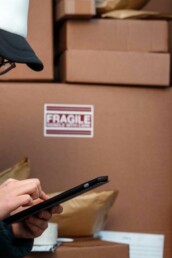The Basics of Standard Shipping
As an e-commerce retailer, you are undoubtedly aware of the importance of offering reliable delivery options to your customers. Consequently, shoppers anticipate a range of delivery choices at the checkout stage. While shipping is a fundamental necessity, it can often feel daunting. Nevertheless, one of the most widely preferred and dependable options is standard shipping. In this article, we will delve into the fundamentals of standard shipping, including delivery times, cost considerations, and strategies for enhancing your overall shipping experience.
What is Standard Shipping?

Standard shipping, also known as regular shipping, is generally regarded as the most economical option for parcel delivery. Referred to as ground, economy, or regular shipping, it represents the baseline level of shipping typically presented at checkout. Not including expedited options like overnight or 2-day delivery, standard shipping is considered the basic, expected delivery method in e-commerce. While it may not be swift, standard shipping reliably fulfills the task at hand.
How long does standard shipping take?
Several factors contribute to how long a package will take to deliver using standard shipping.
- Distance the shipment travels
- Processing time cut-offs
- Standard shipping timeline for the individual carrier
The typical timeframe for a package delivered via standard or ground is 1-5 business days within the continental United States. Conversely, a Hawaiian customer ordering a product from Maine will experience a longer delivery timeline.
What factors contribute to shipping costs?
Similar to determining the time a package takes to be delivered, many factors contribute to the cost. The distance from the warehouse or store to the final destination will be a significant cost factor. Typically, prices are relatively stable within the continental US. Those costs will be slightly higher if you add Puerto Rico, Hawaii, and Alaska. International is an entirely different beast. Other factors that significantly impact the price are the package dimensions and weight. Most major parcel carriers now offer standard-size boxes and maximum weights for a flat rate. This is useful for smaller e-commerce businesses that don’t care about a branded unboxing experience. The carrier will also make a difference in the cost of standard shipping. The graph below compares standard shipping for the largest parcel delivery companies in the continental US.

Ways to improve the standard shipping experience.
According to a study done by Accenture, effective and dependable delivery options are a priority for e-commerce brands to remain competitive. Brands that want to maintain and grow their market share will not only need to provide reliable shipping but will also need to diversify their offerings. A few ways to improve the standard shipping experience include:
Proactive delivery communication.
Giving consumers a delivery window is no longer enough to satisfy customer expectations. They want consistent post-purchase communications to plan and prepare to receive their order. This includes tracking information, delay updates when necessary, and even notifying the consumers when a package is out for delivery. Suppose your parcel delivery company can provide consumers with a preferred delivery window that can be game-changing. This is especially true for large parcel deliveries and those requiring an adult signature. This level of proactive communication improves the standard shipping experience greatly.
Upgrades and delivery alternatives
66% of consumers choose retailers based on the number of delivery options available at checkout. Offering 2-day shipping, expedited, or delivery alternatives must be available to stay competitive. Alternative options to standard shipping that won’t dramatically raise the shipping costs include; BOPIS (Buy Online Pickup In-Store), Curbside, and local delivery or locker systems. If you run a brick-and-mortar store, these alternatives can improve customer satisfaction without negatively affecting the bottom line.
Beginner’s Guide to Third-Party Logistics (3PL)
The world of e-commerce is always changing, therefore understanding the roll of Third-Party Logistics is integral to keeping up. In light of this our beginner’s guide to third-party logistics (3PL) will delve into the essential aspects, offering insights into fulfillment services, warehousing, and much more.
Read More…
Managing the logistics of shipping can become overwhelming quickly. Typically, e-commerce brands use at least three parcel carriers to mitigate the risk of lost packages and delays stemming from single carrier usage. Partnering with a 3PL is an excellent way to scale your standard shipping options. 3PL partners, like Falcon Fulfillment, are experts in fulfillment, delivery, and shipping best practices. They can help your e-commerce brand not just get a package delivered but ensure your growing consumer expectations are not just met but exceeded.





